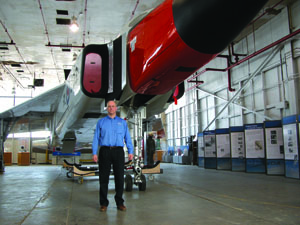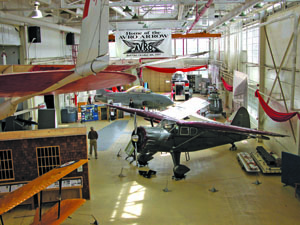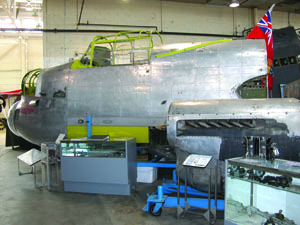

|
| TAM manager Paul Cabot stands in front of the full-scale Avro Arrow replica. |
Now entering its second decade, the Toronto Aerospace Museum not only preserves the city’s aviation heritage; it occupies a structure that itself witnessed some significant elements of that history as it unfolded.
Nestled within a sprawling yellow-brick complex in the middle of what until 1996 was Canadian Forces Base Toronto – and, decades before that, the heart of the de Havilland Canada aircraft plant at Downsview airfield – the Toronto Aerospace Museum (TAM) has made significant progress in the 11 years it’s been in existence. And the dozen-plus aircraft and replicas it proudly displays are only part of the story.
“Our mandate is to preserve and promote the aeronautical history of the Toronto area, and these very rooms we occupy were employed by de Havilland for a number of significant aviation and aerospace projects over the years,” TAM manager/curator Paul Cabot explains as we walk among the exhibits.
“The classic de Havilland Canada DHC-2 Beaver bush aircraft was built in this complex, as was the DHC-1 Chipmunk military primary trainer,” Cabot says. “Also, there was work done in here on the Alouette satellite as well as the guidance system for the Black Brant research rocket. You would be hard pressed to find a more appropriate venue for an aviation museum, and much of the structural interior is unchanged from how it was in the Forties, Fifties and Sixties.”
Today the aerospace museum is just one of several tourist attractions and other activities of Downsview Park, the federally established corporation that inherited much of the old military base when the Department of National Defence substantially moved out in 1996. TAM currently occupies about 35,000 sq. ft. of indoor space on a multi-year lease from the Park.
The de Havilland Canada plant – now part of Bombardier Aerospace – is still very much in operation at Downsview, but its operations have been consolidated south of the now-closed east-west runway. Until the 1990s this northern half of the airfield was a confusing checkerboard of buildings housing Canadian Forces activities and immediately adjacent areas containing de Havilland departments.

|
| All the TAM aircraft are static displays, and are not flown at this time. |
Cabot joined the museum – it currently has about 800 paid-up annual memberships – in 2000. “I’d encountered a booth that TAM had at the Canadian National Exhibition that year, and was intrigued,” he recalls. “I’d done some glider flying when I’d been in Air Cadets many years before, but I certainly didn’t have any significant personal history in aviation or any particular mechanical skills as far as restoring aircraft. Still, I just showed up and told them I’d do whatever needed doing.”
That soon evolved into Cabot being the co-ordinator for many simultaneous activities the young museum was undertaking, as well as making sure the phone got answered, the newsletter got produced, and greater focus was achieved in administration. His past experience as a salesman and adviser in the financial-investment field proved useful, too.
“I found myself volunteering here 35 to 40 hours a week, so it basically became my
full-time job. It’s only more recently that I became manager and actually could draw a bit of a salary,” he says with a smile.
The museum’s first key project was an ambitious one that the original founders had envisioned even before TAM was chartered: to create an accurate, full-scale replica of the famed Avro Arrow jet fighter, a state-of-the-art – but extremely expensive – program for the RCAF that was cancelled by the federal government in early 1959 in a decision that remains controversial to this day.
“The early museum members knew that a really well-done, full-size static replica of the Arrow would be a real attention-getter, so considerable volunteer resources – and vital donations from Canadian companies – were applied to making this a reality,” Cabot says. “In October 2006 we had the rollout, and this display has consistently been one of our most popular.”
Construction of the Arrow replica was taken very seriously, and it’s been mostly made of metal, not just formed fibreglass. The cockpits are complete, with proper controls and instrumentation.
“We don’t receive any ongoing federal or provincial funding, so the hands-on involvement of many of our members, plus some corporate donations, make all the difference,” Cabot says. The idea for a Toronto Aerospace Museum got some valuable publicity in the earliest days from a local television newscaster and journalist specializing in science and space – David Onley, who in 2007 became Ontario’s lieutenant-governor and is now the official patron of the museum.
 |
| Front section of a Lancaster on display at the TAM. |
A group of TAM members now is working on the museum’s next high-profile project: restoring a Second World War-vintage Avro Lancaster Mk. X heavy bomber. This aircraft was built at Malton (within the modern-day perimeter of Toronto’s Pearson International Airport) in 1944, but arrived in England too late to actually fly any combat missions. Upon return to Canada, it ended up at Downsview for conversion by de Havilland into a maritime patrol aircraft, since the Avro plant at Malton was busy with other projects.
After it was retired from the RCAF in 1964, the aircraft wound up outdoors on a pylon in a Toronto park near the Lake Ontario shoreline. The years were not kind to it, and it had deteriorated significantly when the City of Toronto agreed in 1999 to relocate it on long-term loan to the Downsview museum, which committed to undertake a thorough restoration.
“Again,” Cabot says, “we have an aircraft here that has a strong Toronto heritage.” The plan is to restore the Lanc back to its 1945 wartime configuration and markings. There’s no “official” completion date, since so much depends on volunteer availability (and the Lanc project requires very different skills from the Arrow), sources of parts and components, and funding.
All the TAM aircraft are static displays, and are not flown at this time.
“With many of our aircraft, the real story here is how they trigger reactions from people,” Cabot adds. “We’ve had countless visitors come through here and share with us their stories of how a given aircraft type on display had been a part of their lives. I’ll mention just two: we have an elderly lady who comes here regularly, and tells us about her days as a young woman during the Second World War, working on the Lancaster assembly line at Avro. She always has some new incident to share. And, one day Fred Eaton of the department-store family, came here and just freaked out when he saw our little Fleet Canuck: it turns out he learned to fly on one of those.”
Some aircraft have come to the museum by direct personal contribution, including the pristine de Havilland Canada Tiger Moth Second World War biplane primary trainer, which had been built in 1942 in the very area now occupied by the museum, and which owner/
restorer Bob Laidlaw flew to Toronto from his current home in California.
His route included visiting the airfields in Manitoba where this specific aircraft had served during the war. As he arrived in Brandon, however, the aircraft’s engine threw a rod. When word got back to TAM about this mishap, museum member Bob Murphy volunteered to provide a replacement engine that he owned, but which was located in Oshawa, Ont.
So the little biplane was disassembled and crated, taken to Oshawa by train, and the necessary repairs were accomplished. Intrepid aviator Laidlaw then at last flew his Tiger Moth to a safe delivery at Downsview.
Another high-interest display is the original Easy Riser ultralight aircraft that Ontarian Bill Lishman first used to teach abandoned baby Canadian geese to go into formation on him in the air. This was part of his innovative plan that later employed a larger ultralight to actually lead the young geese on the necessary fall migration into the southern U.S. (this story was immortalized in the 1996 motion picture “Fly Away Home”).
Future plans for the Toronto Aerospace Museum are extensive, and a study now being finalized looks at options for more efficient use of display space as well as physical growth. But much depends on developing a larger revenue flow. Membership dues, gift-shop revenues, plus renting out areas of the museum for television and motion-picture shoots, help – but can only do so much.
“Our annual attendance is currently running between 20,000 to 25,000 visitors a year, and we really need to at least triple that for starters, and then look to breaking the 100,000 level,” Cabot reports. “As far as exhibit space goes, we definitely will need to expand in some fashion if we’re to accommodate any more large aircraft, because we absolutely refuse to let any aircraft be subjected to the deterioration you get from sunlight and climate changes outdoors.”
Cabot reveals that the museum is in advanced negotiations to try to acquire the original circa-1958 prototype de Havilland Canada DHC-4 Caribou twin-engine STOL (short takeoff and landing) military transport. It’s currently located in Ypsilanti, Mich., and its actual ownership status is somewhat unclear.
“We’d really like to make it part of our museum, and we think it’s in good enough shape that we could get a ferry permit to actually fly it into Downsview,” Cabot says. “Stay tuned for more news on our efforts to bring home this significant part of Toronto aviation-industry history.”
As I walked out to my car, I knew I’d be back more than once to follow the saga of this little gem of an air museum and its band of enthusiastic supporters.
Contact information: Toronto Aerospace Museum, 65 Carl Hall Rd., Toronto, ON M3K 2E1. Tel. 416-638-6078. E-mail for tours for school and other groups: education.
tam@bellnet.ca. Visit the Museum website: www.toronto
aerospacemuseum.com.